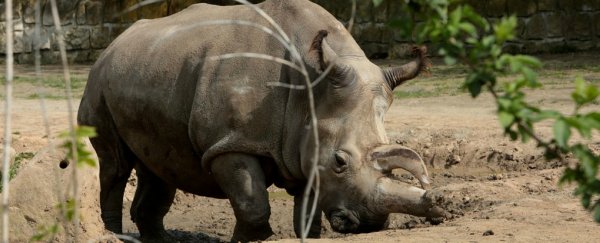On the back of the devastating news that Zimbabwe's largest lion Cecil had been killed and skinned by a hunter, zoo keepers reported overnight that one of the world's five remaining northern white rhinos has died from a ruptured cyst.
Nabire was a 31-year-old female and was born, raised and also died in the Dvůr Králové Zoo in the Czech Republic. She'd suffered from cysts on her reproductive system her entire life, which is why she'd never been able to produce offspring despite several natural breeding attempts, as well as in vitro fertilization (IVF).
Nabire leaves behind three other females - two in the Ol Pejeta Conservancy in Kenya and one at the San Diego Zoo Safari Park - and just one male in Kenya, called Sudan, who has had his horns removed and is guarded round the clock by armed guards.
Unfortunately, Nabire's death delivers a pretty hefty blow to the outlook of the species, which has had its numbers rapidly reduced by poaching and habitat loss over the past 20 years. With such little genetic diversity left, even if zookeepers could breed new offspring, it's unlikely they'd be very resilient to natural selection.
Still, researchers haven't given up hope just yet. The zookeepers at Dvůr Králové removed Nabire's healthy ovary as soon as she died, and they're now working on harvesting any remaining eggs. As Rachel Feltman reports for the The Washington Post, these eggs will still be immature (the rhinos only release a mature egg every 30 days) but scientists hope they might be able to coax them into maturity in the lab.
If they can accomplish this, they'll try to use sperm from Sudan, or frozen sperm that's been collected over the years, to fertilise the egg, and then implant it into a similar species such as the southern white rhino in an attempt to produce new offspring.
Researchers at the San Diego Zoo are also working on sequencing the northern white rhino's genome. "Multiple steps must be accomplished to reach the goal of establishing a viable population that can be reintroduced into the species range in Africa, where it is now extinct," San Diego Zoo geneticist Oliver Ryder told the zoo's blog earlier this year. "A first step involves sequencing the genomes of northern white rhinos to clarify the extent of genetic divergence from their closest relative, the southern white rhino."
Of course, this is all very expensive, and the northern white rhinos aren't the only species we need to invest in. Scientists are also desperately trying to find ways to protect the remaining black rhinos in the wild from poaching. They've already experimented with drone surveillance, and armed guards, and are now looking into implanting spy cameras into their horns, as well as fitting them with alarms, so that helicopters can be deployed at the first sign of poachers. Members of the public also last month crowd-funded the sequencing of the black rhino's genome in the hopes of finding clues that might help keep the species alive.
But there are also researchers out there who think it may be too late to save species such as rhinos and pandas, and that the resources could potentially be better spent trying to help out more viable survivors. And as sensible as that is, it's a pretty heartbreaking choice to have to make when so many of these creatures have been wiped out by human activity in the first place.
One thing's for sure, it would definitely be a big win if our human ingenuity could bring a species back from the brink of extinction for once, instead of putting them there.
